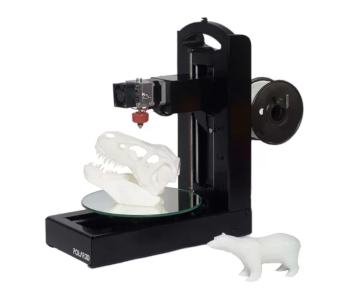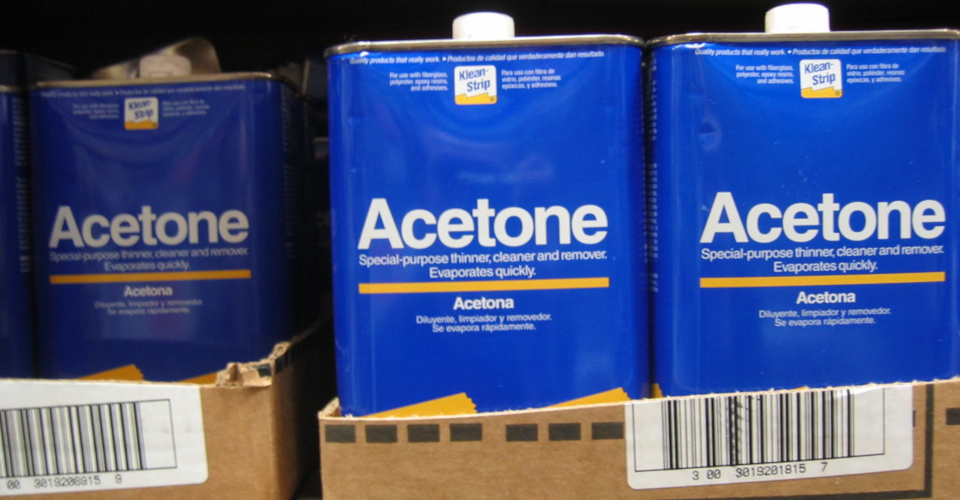How to Use Acetone to Smooth Your ABS Prints
Fused deposition modeling (FDM) may be the easiest and cheapest way to get into 3D printing, but it is not without its limitations. It can take a really long time to finish a print with FDM, and it’s almost impossible to print designs with very fine details. Due to the process of laying down molten filament layer by layer, FDM prints also naturally come out with layer lines. These imperfections are simply unacceptable for professional-grade work.
If you’re working with ABS, then the good news is that you can easily smooth your finished print with just one easily available ingredient: acetone. Why is acetone uniquely suited to ABS? What’s the process for smoothing ABS prints using acetone?
How does acetone smooth ABS prints?

If you put a piece of ABS filament in a container of acetone and give it a good stir, you’ll find that the filament disappears after just a few seconds. This is because ABS, a petroleum-derived plastic, is highly soluble in an organic solvent like acetone. Other petroleum-derived filaments, such as HIPS, ASA, and Polycarbonate, are also soluble in acetone.
As a side note, dissolving copious amounts of ABS filament in acetone is how you make your very own ABS glue. This is one of the most reliable methods of improving bed adhesion when you are printing with an ABS filament.
How does the solubility of ABS in acetone play a role in the smoothing process? This means that, by exposing the surface of raw ABS prints to acetone, minor imperfections can be “melted” away, which should ideally result in a perfectly smooth surface.
What is an acetone vapor bath?
Even if you haven’t done an acetone vapor bath before, you’ve probably heard the term being thrown around in 3D printing communities and blogs. A vapor bath is the most common way to use acetone to smooth ABS prints because of the ease with which it can be done and the quality of its results. It involves turning a portion of liquid acetone to vapor and exposing your ABS print to these vapors.
This results in a very slow and controlled dissolution of the print’s outer surface, smoothing the surface without resulting in a loss of detail. Since the ABS material is being dissolved by vapor, even the smallest nooks and crannies of the print will be smoothed. The acetone vapor also covers the entire ABS print, which means that the print will be smoothed uniformly throughout.
Fortunately, acetone has a very low boiling point and readily turns into vapor even in room temperature. This makes the process of giving your ABS print an acetone vapor bath a relatively simple one. You won’t need any fancy equipment for this one – the stuff you can find around your house will do.
Acetone also has the advantage of being a cheap and readily available chemical. It is popularly known as a nail polish remover and is also widely used as a cleaning agent for industrial laboratories. You can buy an 8-oz. bottle of commercial-grade acetone for less than $10.
What you will need to smooth your ABS print using acetone
Smoothing your ABS print using an acetone vapor bath is a very simple process. Aside from the acetone itself, you probably won’t need to buy any other piece of equipment. To set yourself up, just round up this list of items:
- A bottle of 99.5% acetone
- A small metal platform, large enough to support your print
- A drinking glass big enough to contain your print
- A shallow non-plastic tray that is wider than the mouth of the drinking glass
- Paper towels
- A timer
This list of items will only work if you have an ABS print small enough to fit inside a drinking glass. If you have a bigger print, then you’ll need to scale up all of your equipment. You will still need a transparent container so that you can keep an eye on your print while the acetone vapor does it work. Take note that you should not use any plastic material during this process, as the acetone could just dissolve right through it.
A step-by-step guide to smoothing your ABS print using acetone
- Place the metal platform in the middle of your tray, and set the ABS print on top of it. Make sure that everything is stable.
- Stuff the bottom of the drinking glass with some paper towel. Use enough paper towels so that that the fit is snug and that the paper towels don’t fall off when you turn the drinking glass over.
- At this point, you can try turning the drinking glass over your ABS print. This is to make sure that the paper towel does not come into direct contact with the print. If it does, you might need to get a taller glass or a shorter metal platform. Repeat the process until you get it right.
- Pour acetone into the paper towel at the bottom of the drinking glass. Pour just enough to get the paper towel completely wet but not so much to soak it. Turn the drinking glass over the plastic tray, completely covering the ABS print and the metal platform.
- At this point, the acetone on the paper towel is already slowly turning into vapor. Acetone vapor is lighter than air, so the space inside the drinking glass will be slowly filled with acetone from the top down. Give the air some time to escape through the bottom of the glass – about 10 minutes will do.
- After about 10 minutes, line the bottom of the glass with paper towels that have been soaked with water. This prevents the acetone vapor inside the glass from escaping.
- Start the timer. Depending on the size and the surface area of your print, the time it takes to get a perfectly smooth surface using an acetone vapor bath may vary. This can take between 15 minutes to an hour. To make sure that you don’t go overboard, check on your print every 10 minutes.
- This one’s important: you will need to remove your print from the vapor bath as soon as you think that it’s halfway done. It might be hard for you to identify this point if it’s your first time doing an acetone vapor bath, but you’ll get better the more you do it. The best tip we can give you is to stop the vapor bath as soon as you notice a sheen developing on the print’s surface.
- Set the print aside in a well-ventilated and dust-free area. At this point, the surface of the ABS print is still soft as it still has some acetone on it. The smoothing process will continue until all the acetone on the surface of the print has dried away. The whole process of removal of acetone can take from several hours to a few days to complete. All you need, at this point, is just a little bit of patience.
A few tips when doing an acetone vapor bath
1. Pick a well-ventilated area
Acetone turns into vapor as soon as you open its bottle. Throughout the whole process of giving your ABS print an acetone vapor bath, you’ll probably end up with quite a lot of acetone vapor swirling around you. While inhaling acetone in small amounts is pretty harmless, it’s still a gas that can easily catch fire. When working with acetone, do it in a well-ventilated area.
2. Wear gloves and goggles when handling acetone
Although acetone is commonly used in households as a nail polish remover, having it on your skin could still cause itching and irritation. You also wouldn’t want any acetone vapor to end up in your eyes, as they could cause a burning sensation. Before opening your bottle of acetone and pouring it into those paper towels, make sure that you’re wearing protective gloves and goggles. Yes, acetone may not be a highly toxic chemical, but there’s no reason not to protect yourself.
3. Use a good ABS filament
This tip has more to do with the quality of your finished product: make sure that you buy and use a high-quality ABS filament. Cheap filaments may contain additives made of other plastics which may not react with acetone the way the pure ABS does. The telltale sign of poor-quality ABS filaments is a pock-marked surface when treated with an acetone vapor bath. Make sure that all your hard work doesn’t go to waste, and only buy your ABS filaments from reputable brands.
Final thoughts
The ability to perfect 3D prints using smoothing and finishing methods is one of the things that separates 3D printing professionals from amateurs. Smoothing ABS prints using an acetone vapor bath is one of the easiest ways to start – it doesn’t require a lot of skill, hardly needs any manual work, and has a lot of room for error. It might take a few tries before you can get perfect results, but this isn’t rocket science – we’re confident that you can do it.



I was looking for information on this subject. I will use the information you provided. I have worked to remove roughness in 3D Objects that I have printed. What you have told will enable me to achieve clean and quality results.